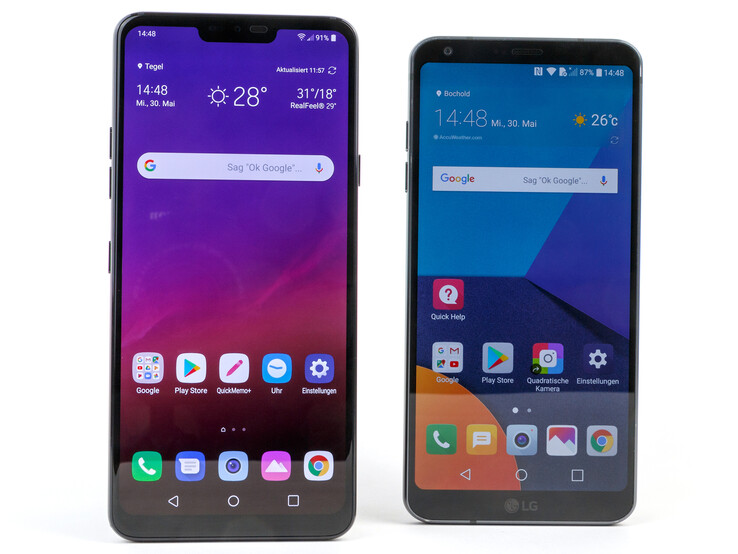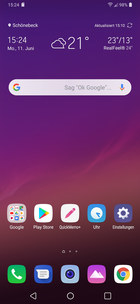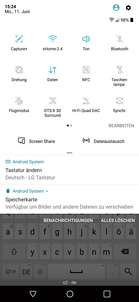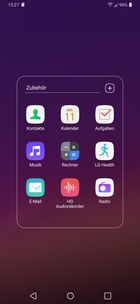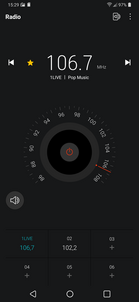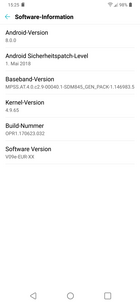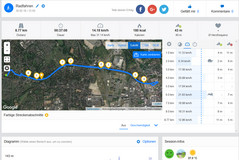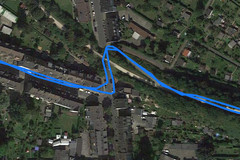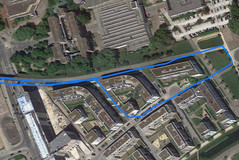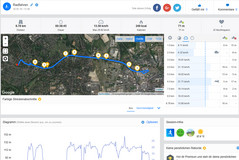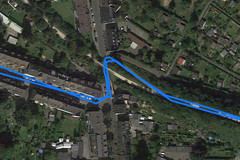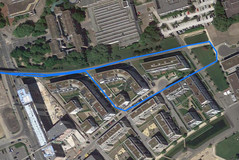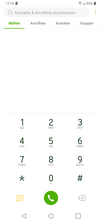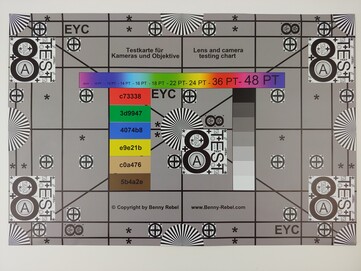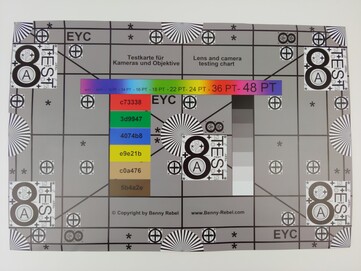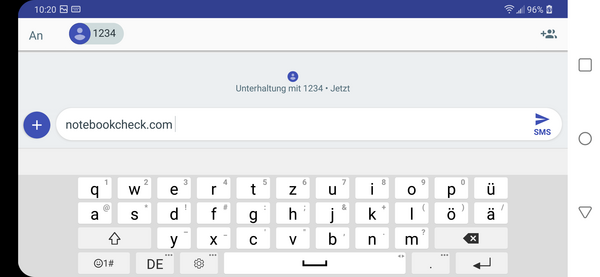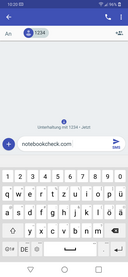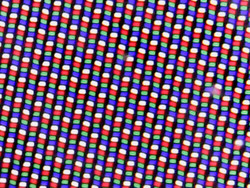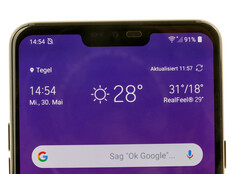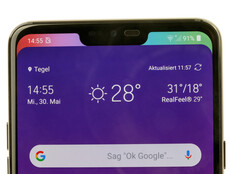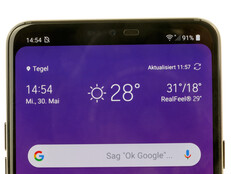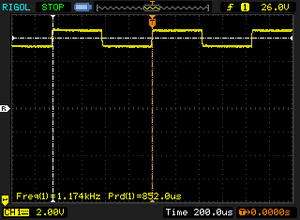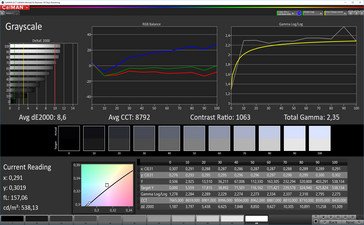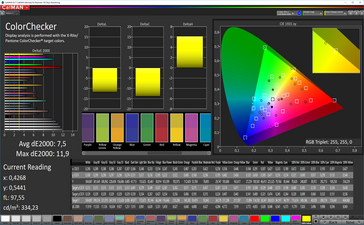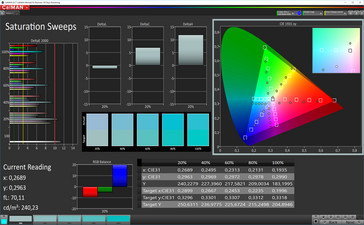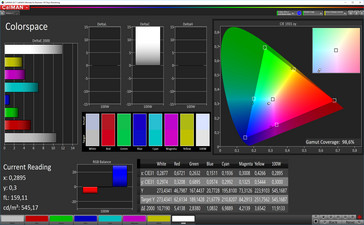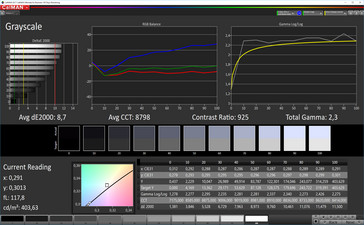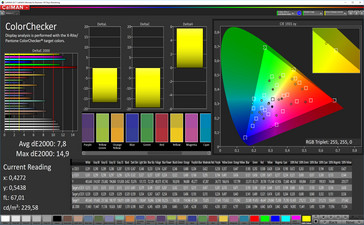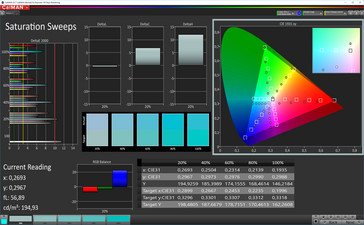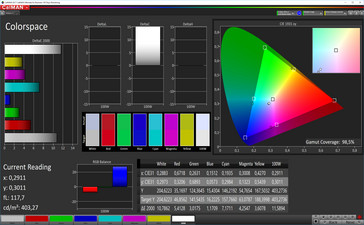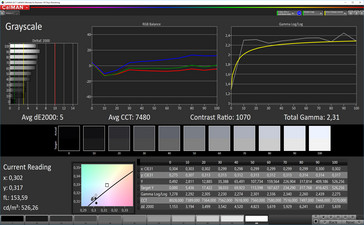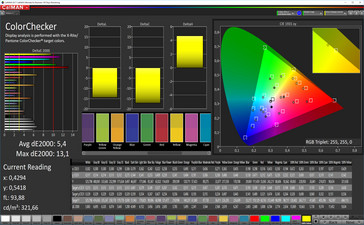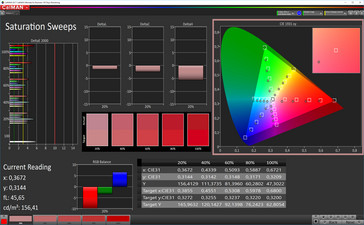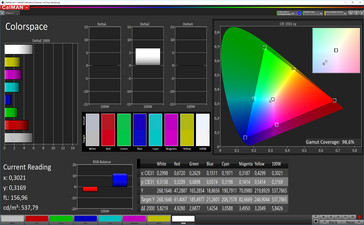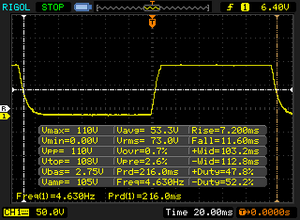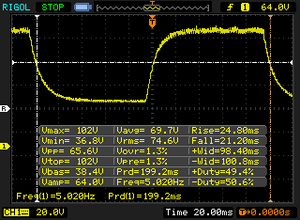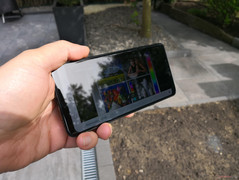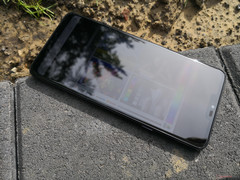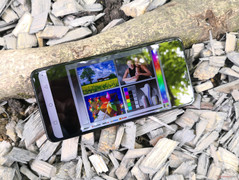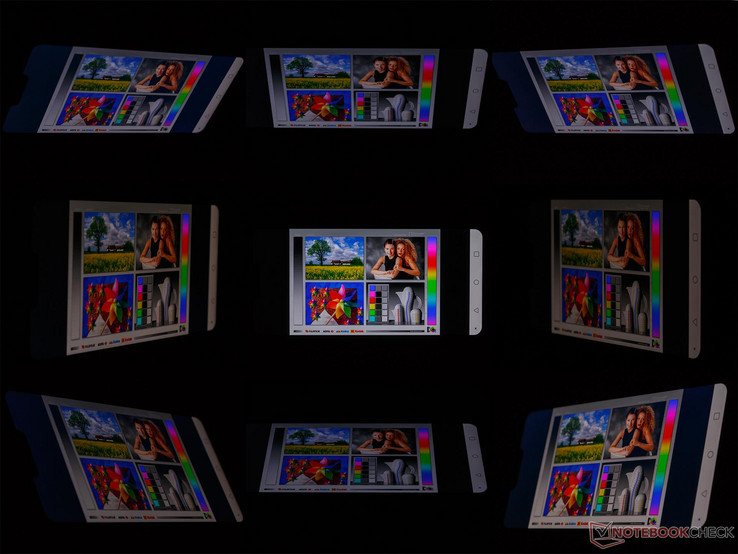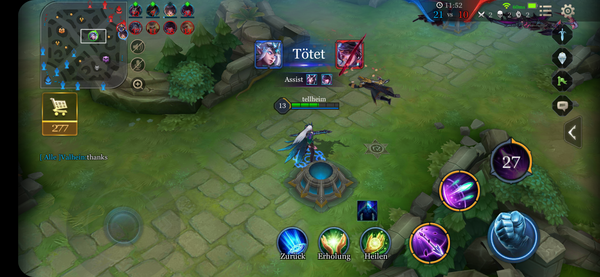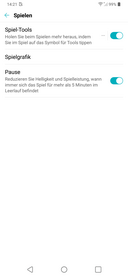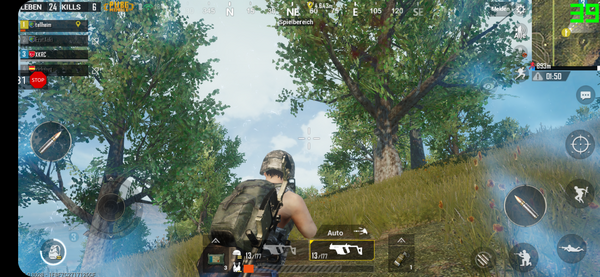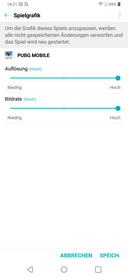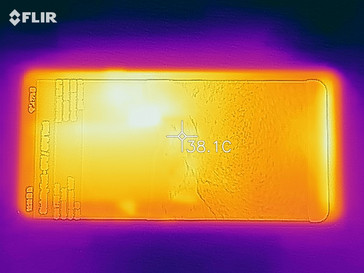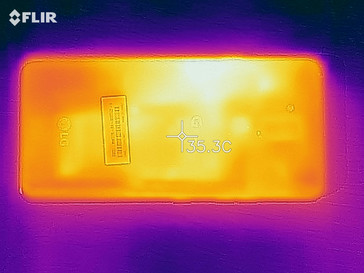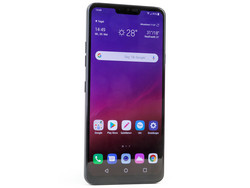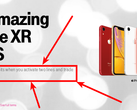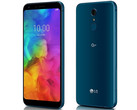LG G7 ThinQ Smartphone Review
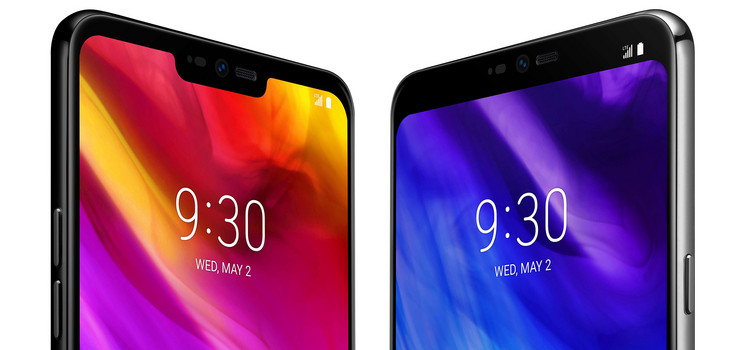
The LG G6 received plenty of criticism from us for its regional variants that had different hardware and for its outdated processor. LG has sought to make up for these shortcomings with the LG G7 ThinQ, a smartphone equipped with the latest premium Qualcomm SoC, a Hi-Fi Quad DAC and wireless charging. These features are even present in the European variants this time around. The G7 ThinQ is IP67 and MIL-STD-810G rated, which should protect the device from the elements and from most drops. The 4 GB RAM and 64 GB of internal storage is standard for premium devices released in 2018, with many manufacturers offering higher volumes. Fortunately, there is support for up to 2 TB microSD cards for those that need more storage.
The ThinQ branding refers to the AI camera support, which LG has already introduced with the LG V30. LG has reduced the battery capacity between generations by 300 mAh to 3,000 mAh. It appears LG favors a slimmer chassis over battery capacity.
The G7 ThinQ sports an mLC display, the first smartphone to do so. This technology not only supports HDR10 but also offers display brightness up to 1,000 nits.
The G7 ThinQ is 100 Euros (~$116) more expensive than its predecessor, retailing for 849 Euros (~$986) at the time of writing.
In this review, we will be comparing the G7 ThinQ against other premium smartphones. These are the Samsung Galaxy S9+, the Huawei P20 Pro, the iPhone X, the HTC U12 Plus, the Sony Xperia XZ2, the OnePlus 6 and the Google Pixel 2 XL.
Case
The G7 ThinQ packs a large 6.1-inch display into its relatively small case thanks to its narrow display bezels. The back of the case has the same Corning Gorilla Glass 5 as the front, which is a fingerprint magnet notwithstanding its scratch-resistant qualities. The dual-rear camera system protrudes 0.35 mm from the back case. We would have preferred the camera housing to have sat flush with the back case. The G7 ThinQ officially measures 153.2 x 71.9 x 7.9 mm. We measure our test device as 8.2 mm deep though, which is probably because of the rounded edges at the side.
The G7 ThinQ feels premium and good in the hand. The gaps are even and tight on the front device. Unfortunately, the workmanship isn’t as good on the rear, with some edges not being as close to the frame as we would have liked. Our test device could not be twisted despite our attempts, but we could get the LCD to temporarily distort by applying some pressure to the display. The G7 ThinQ is IP68 and MIL-STD-810G rated like its predecessor and the V30. MIL-STD-810G means that the device successfully passed 14 environmental and climatic tests. It is worth bearing in mind that no independent organization or agency certifies MIL-STD-810 compliance, so take the certification with a pinch of salt.
The G7 ThinQ will be available in Germany in either Aurora Black or Platinum Silver. The black version is not completely black as it has a bluish shimmer depending on the angle at which light hits the device. The G7 ThinQ will be available in Moroccan Blue and Raspberry Rose in other regions like the USA.
The battery is built-in and not user removable. The card tray can either take two nano-SIMs or one SIM card and one microSD card. The tray is made of plastic and feels sturdy. LG has moved the power button from the back to the right-hand side, while the volume rocker and Google Assistant button can be found on the opposite side.
Connectivity
Little has changed compared to the LG G6. The G7 ThinQ supports wireless media transmission by DLNA, Wi-Fi Direct, Miracast and Android Beam. The USB Type-C port supports OTG so external storage devices and peripherals can be connected. The Type-C port is USB 2.0, so image output via USB is not possible.
The microSD card cannot be formatted as internal storage. This restricts the microSD card to storing images and other media. It is worth noting that there is a setting that allows app data to be stored on the microSD card, which is buried within Developer Options.
Additionally, the G7 ThinQ is equipped with a dedicated Google Assistant Button, an FM Radio and it supports both NFC and Bluetooth 5.0.
Software
The G7 ThinQ ships with Android Oreo 8.0, on top of which LG adds its own skin. LG installs several additional apps including an HD audio recorder, a radio app, LG Health, McAfee Safe Family, LG SmartWorld, Facebook and Instagram. Third-party apps cannot be uninstalled, but they can be disabled.
The G7 ThinQ supports multiple accounts. These additional accounts are more restricted compared to the primary account. These secondary accounts can also be managed by the primary account.
Our test device arrived with Android security patch level May 1, 2018, which was last month’s security patch at the time of writing. We expect that LG will release two major feature updates for the G7 ThinQ, but this has not been officially confirmed.
We should point out that LG installed pre-release software on our test device that will not receive updates and that is more restricted than the final version. Our test device could not run benchmarks that require an Internet connection for example.
Communication & GPS
The G7 ThinQ competes with other current high-end smartphones in terms of the communications hardware that LG has included. The G7 ThinQ supports IEEE 802.11 a/b/g/n/ac dual-band Wi-Fi thanks to its MIMO antenna. This allowed our test device to achieve consistent and high transfer speeds with our Linksys EA8500 reference router. The range is impressive too. Our test device managed to stream an HD video without issue when about 10 meters from the router and next to an outer wall. Signal attenuation is equally good on either 2.4 or 5 GHz networks.
The G7 ThinQ is unremarkable in our LTE test. The device supports LTE Cat. 18, which supports up to 1.2 Gb/s download speeds, but LG has limited upload speeds to 75 Mb/s. By contrast, the Qualcomm X20 modem supports up to 150 Mb/s.
The G7 ThinQ uses A-GPS, GPS, Glonass, BeiDou and Galileo to provide location services. Our test device manages to locate itself within around four seconds indoors and practically immediately when outdoors. Outdoor GPS accuracy is at approximately three meters.
We took the G7 ThinQ on a bike ride to test its location accuracy against a professional navigation device, the Garmin Edge 500. Our test device performed well, recording the course and only deviating by 10 meters over an 8.77 km ride. Overall, the G7 ThinQ should be suitable for all general navigation tasks and even those where higher precision is required.
Telephone Function & Call Quality
The phone app is well structured and easy to use. Our test device has good call quality at both ends of the call so long as the phone is held to your ear. Using the speaker adds a slight background noise to the call, while voices recognizably echo. This is not that distracting, but it is noticeable.
The G7 ThinQ supports neither VoLTE nor Wi-Fi calling in Germany. While this should not be a problem in practice as the phone signal is plentiful and the call quality is good, we expect to see both in a 2018 device at this price.
Cameras
The front-facing camera is once more based on an 8 MP sensor (4:3, f/1.9, 80 degree) that at least on paper is supposed to be very bright. Videos are recorded in FHD (1920 x 1080, 30 FPS) and are software-stabilized. The camera also supports a so-called AI-Cam feature which analyzes your photos with AI algorithms and optimizes them accordingly, an AR sticker mode, and a beauty mode. Photos taken with it turned out surprisingly good and kept the person in focus as long as the beauty filter was not applied to liberally. However, it failed to capture different levels of lighting and darkened the background accordingly. The portrait mode further improved selfies, but the transition between the object in focus and the blurry background was far from perfect.
The dual camera at the rear has been improved dramatically when compared to the LG G6, however the result did not always result in a better photo quality. The 16 MP Sony IMX351 sensor with an optically stabilized 71-degree f/1.6 lens took very decent photos rich in detail and focus at the center but significantly less so towards the edges. Dynamic range was very high, although we noticed some clouding in the first scene. Generally speaking this AI Cam improved photo looks more like a painting with less details than expected. The AI obviously went overboard on this photo. It did much better for the second scene even though photo quality was not as high as on the G7’s competitors. Under low-light conditions the device increased brightness drastically, which looked astonishingly beautiful on the display but failed to pass our quality tests at 100 % zoom. Shutter lag was acceptable but we would have preferred a lower latency, especially with AI Cam enabled or when taking several photos back-to-back.
The secondary lens (107-degree wide angle, f/1.9, 16 MP Sony IMX351) did very well by and large, and offered a similar photo quality as the primary lens. When filming, for example, we failed to notice any differences. They did, however, become very noticeable in low-light conditions. The wide-angle lens distorts photos visibly and is best used primarily for landscape or architecture shots. It also failed to focus for distances of less than 1 m (around 1.1 yards).
Videos are recorded in UHD at 30 FPS or FHD at 60 FPS. There is no time limit regardless of resolution. Video quality was very good and the stereo sound recordings turned out particularly well. Zooming while filming or additional audio settings that we encountered in our V30 review are not supported.
Examplary photos LG G7 ThinQ: left default 71-degree camera, right 107-degree wide-angle camera
As always we have also tested the LG G7’s cameras under normalized conditions in our lab. Colors turned out somewhat bright and oversaturated, and the wide-angle lens was a bit darker with an overall warmer white balance.
The main camera’s photo of our test chart was very detailed and crisp in the center of the photo. Edges were very clear and clean. However, we did notice artefacts on the Gray background and the color gradients were not perfect either. Details and sharpness suffered immensely towards the edges. The wide-angle lens had similar problems although its artefacts were less pronounced. Our test chart photo was not in focus because the distance required for a full-size photo was not enough. Even when moving further back we had trouble focusing on the test chart – an issue we did not encounter during everyday use.
Accessories & Warranty
Our test device came with a modular charger (9 V, 1.8 A, 5 V, 1.8 A), a USB Type-A to Type-C cable, a set of headphones with spare attachments, a SIM tool and a cleaning cloth. The headphones look relatively high-quality for those that are typically included with smartphones and have a textured cable.
The G7 ThinQ comes with 24 months warranty. Please see our Guarantees, Return policies and Warranties FAQ for country-specific information.
Input Devices & Operation
The G7 ThinQ has a 10-point multitouch capacitive touchscreen that accurately and quickly reproduces inputs even at the edge of the display.
LG continues to use its own keyboard as the default. The LG keyboard has many features, but it can easily be replaced with another keyboard from the Google Play Store if you prefer.
The G7 ThinQ has a fingerprint scanner on the back of the device that works well provided that your fingers are dry. Not only does your fingerprint unlock the device, but it can also be used to protect parts of the Gallery app and the QuickMemo+ notetaking app. There is also face recognition that works surprisingly well in low light. The software lacks the security of the iPhone X’s Face ID and can be easily spoofed.
A large display is all well and good, but it comes at the expense of one-handed use. The G7 ThinQ is difficult to use one-handed in our opinion, but fortunately, LG includes a one-handed mode called Mini view. This must be enabled in Settings, and it is activated by swiping left or right from the home button. The display can then be freely shrunk to approximately between 3.5 and 4.5-inches. It is worth noting that the last used screen size is not retained when you re-enable Mini view.
Display
The G7 ThinQ has a 6.1-inch display with a 13:6 aspect ratio. You may see this mentioned elsewhere as a 19.5:9 aspect ratio. The G7 ThinQ has a 3120x1440 native resolution and is the first smartphone to be equipped with an mLC display. LG boasts that this technology not only supports HDR10 but also allows the display to get incredibly bright.
The sub-pixel array clearly shows the high concentration of pixels and the additional white pixel, which gives the display an RGBW matrix. This can also be found in other premium Huawei smartphones like the Huawei Mate 10, which has an LTPS display.
The G7 ThinQ has an incredibly high pixel density at 564 PPI. Images are sharply displayed as a result. LG claims that the G7 ThinQ has a 1,000-nit display, which our tests using X-Rite i1Pro 2 confirm, albeit not uniformly so. We measured a maximum average brightness of 974 cd/m² with a 96% even brightness distribution. We measure brightness by dividing the display into nine areas. While all areas exceed 900 cd/m², only one reached 999 cd/m². Moreover, we could only achieve this with the ambient light sensor activated and a pure white image displayed onscreen. When we measured display brightness with APL 50, which evenly distributes light and dark areas, the average maximum luminosity drops to 948 cd/m². Furthermore, disabling automatic brightness means that the display maxes out at 591 cd/m². There is a button to temporarily boost brightness when using manual mode. This increases luminosity up to 935 cd/m². Overall, the G7 ThinQ has an incredibly bright display that remains so regardless of lighting conditions.
It’s not all great news though as the black value could be better. Our test device has a 0.49 cd/m² black value, which is much higher than the LG G6’s 0.23 cd/m². This results in the G7 ThinQ having a much lower contrast ratio than its predecessor. Nonetheless, the G7 ThinQ still has an impressively high 1,988:1 contrast ratio that is much better than our comparison devices that have LCD displays. The G7 ThinQ cannot compete in this regard with our comparison devices that have OLED displays, but this only highlights the differences between LCD and OLED displays more than anything else.
Unfortunately, the ThinQ uses PWM to regulate brightness at 42% brightness and below. The frequency is relatively high at 1,174 Hz, but it is detectable over a large portion of brightness, so those who are sensitive to PWM should bear this in mind. Additionally, we did not notice any backlight bleeding during our tests.
The G7 ThinQ has a notch in the display around which the display curves. The area around the notch can be configured in Settings under “New Second Screen” or hidden to give the display a more traditional aspect ratio. The device changes these areas around the notch to black, but the notch is still visible in dark environments as the mLC display cannot reproduce true blacks like OLED displays can.
LG includes a blue-light filter called Comfort view, which changes the color temperature and can even switch to just black and white. Both can be set to a timed schedule if required.
There is also an optional always-on display that can display a clock, notifications, quick tools and music player controls while the device is in standby. While the always-on display is functional, its practicality is limited by the mLC display. The display cannot switch individual pixels on or off as an OLED panel can, which means that the whole panel is turned on when the always-on display is active. Not only does this drain more battery than an OLED panel would with always-on display active, but it also means that the entire display is lit up at night, which is surprisingly bright.
An illustration of the various notch modes available, which LG names New Second Screen.
| |||||||||||||||||||||||||
Brightness Distribution: 96 %
Center on Battery: 974 cd/m²
Contrast: 1988:1 (Black: 0.49 cd/m²)
ΔE Color 5.4 | 0.5-29.43 Ø5
ΔE Greyscale 5 | 0.57-98 Ø5.3
Gamma: 2.31
| LG G7 ThinQ IPS, 3120x1440, 6.10 | LG G6 IPS LCD, 2880x1440, 5.70 | Samsung Galaxy S9 Plus Super AMOLED, 2960x1440, 6.20 | Apple iPhone X Super AMOLED, 2436x1125, 5.80 | Huawei P20 Pro OLED, 2240x1080, 6.10 | Sony Xperia XZ2 IPS, 2160x1080, 5.70 | OnePlus 6 Optic AMOLED, 2280x1080, 6.28 | HTC U12 Plus Super LCD 6, 2880x1440, 6.00 | |
|---|---|---|---|---|---|---|---|---|
| Screen | 6% | 17% | 24% | 24% | 14% | 9% | 10% | |
| Brightness middle | 974 | 646 -34% | 565 -42% | 600 -38% | 569 -42% | 630 -35% | 430 -56% | 395 -59% |
| Brightness | 975 | 611 -37% | 571 -41% | 606 -38% | 578 -41% | 632 -35% | 437 -55% | 402 -59% |
| Brightness Distribution | 96 | 89 -7% | 96 0% | 94 -2% | 95 -1% | 96 0% | 87 -9% | 90 -6% |
| Black Level * | 0.49 | 0.23 53% | 0.44 10% | 0.37 24% | ||||
| Contrast | 1988 | 2809 41% | 1432 -28% | 1068 -46% | ||||
| Colorchecker dE 2000 * | 5.4 | 4.5 17% | 2.3 57% | 1.2 78% | 1.3 76% | 1.5 72% | 2.3 57% | 1.6 70% |
| Colorchecker dE 2000 max. * | 13.1 | 8.3 37% | 4.8 63% | 3 77% | 2.1 84% | 4.3 67% | 4.6 65% | 3.4 74% |
| Greyscale dE 2000 * | 5 | 6 -20% | 1.9 62% | 1.6 68% | 1.6 68% | 2.1 58% | 2.4 52% | 1.1 78% |
| Gamma | 2.31 95% | 2.27 97% | 2.16 102% | 2.23 99% | 2.31 95% | 2.17 101% | 2.28 96% | 2.14 103% |
| CCT | 7480 87% | 7996 81% | 6332 103% | 6707 97% | 6401 102% | 6513 100% | 6160 106% | 6536 99% |
| Color Space (Percent of AdobeRGB 1998) | 67.74 | |||||||
| Color Space (Percent of sRGB) | 99.05 |
* ... smaller is better
Screen Flickering / PWM (Pulse-Width Modulation)
| Screen flickering / PWM detected | 1174 Hz | ≤ 42 % brightness setting | |
The display backlight flickers at 1174 Hz (worst case, e.g., utilizing PWM) Flickering detected at a brightness setting of 42 % and below. There should be no flickering or PWM above this brightness setting. The frequency of 1174 Hz is quite high, so most users sensitive to PWM should not notice any flickering. In comparison: 53 % of all tested devices do not use PWM to dim the display. If PWM was detected, an average of 17900 (minimum: 5 - maximum: 3846000) Hz was measured. | |||
The G7 ThinQ has numerous color profiles and options to customize the color rendering to suit individual preferences. We measured the automatic, eco and cinema modes using our photo spectrometer and CalMAN software. We achieved the best results with cinema mode. Other modes either looked too cool or had a magenta or green tint to them. The expert mode offers more comprehensive options, but we couldn’t achieve better color reproduction with this mode.
The cinema mode has a slight blue tint in grayscale, which is passable for daily use. The colors are rather undersaturated and we would prefer a bit more luminosity, with the red being particularly affected. DeltaE 2000 divergences are passable and barely visible to the naked eye. Red is the strongest deviation in mixed color tests, but even this hardly falls short of desired intensity. Positively, the DCI-P3 color space is practically completely covered.
Unfortunately, color representation is only average for a premium smartphone released in 2018. The competition is much better in this regard.
Display Response Times
| ↔ Response Time Black to White | ||
|---|---|---|
| 18.8 ms ... rise ↗ and fall ↘ combined | ↗ 7.2 ms rise | |
| ↘ 11.6 ms fall | ||
| The screen shows good response rates in our tests, but may be too slow for competitive gamers. In comparison, all tested devices range from 0.1 (minimum) to 240 (maximum) ms. » 36 % of all devices are better. This means that the measured response time is better than the average of all tested devices (21.5 ms). | ||
| ↔ Response Time 50% Grey to 80% Grey | ||
| 46 ms ... rise ↗ and fall ↘ combined | ↗ 24.8 ms rise | |
| ↘ 21.2 ms fall | ||
| The screen shows slow response rates in our tests and will be unsatisfactory for gamers. In comparison, all tested devices range from 0.2 (minimum) to 636 (maximum) ms. » 76 % of all devices are better. This means that the measured response time is worse than the average of all tested devices (33.7 ms). | ||
The G7 ThinQ is usable in direct sunlight thanks to its incredibly bright display. In practice, our test device is hardly brighter than the Galaxy S9+ or the Mate 10 Pro, both of which can get very bright. This may be because the G7 ThinQ tends to dim the display more than we would like with auto brightness enabled. The luminosity boost tends to take a while to kick in too.
Performance
The G7 ThinQ is powered by a Qualcomm Snapdragon 845 SoC, which is paired with Adreno 630 graphics among other things. The G7 ThinQ is also equipped with 4 GB RAM. This is sufficient in daily use, but it is potentially less future-proofed than some competitors with 6 GB or 8 GB RAM.
Our test device runs pre-release software, which unfortunately means that we were unable to run many of our usual benchmarks. The benchmarks that we could run demonstrated that the G7 ThinQ is on par with other Snapdragon 845-powered devices.
System performance is exceptional and is only marginally surpassed by the OnePlus 6 and the HTC U12 Plus. We recommend deactivating the Google feed if you do not need it as it can cause minor stutters on the home screen.
| Lightmark - 1920x1080 1080p (sort by value) | |
| LG G6 | |
| Google Pixel 2 XL | |
| Huawei P20 Pro | |
| Samsung Galaxy S9 Plus | |
| Basemark ES 3.1 / Metal - offscreen Overall Score (sort by value) | |
| LG G7 ThinQ | |
| LG G6 | |
| Apple iPhone X | |
| OnePlus 6 | |
| Google Pixel 2 XL | |
| Huawei P20 Pro | |
| Samsung Galaxy S9 Plus | |
| Average Qualcomm Snapdragon 845 (1169 - 1201, n=5) | |
| Average of class Smartphone (177 - 6114, n=58, last 2 years) | |
The G7 ThinQ performed well in browser benchmarks and is on par with other Snapdragon 845-powered devices. Browsing the web on the preinstalled Google Chrome 66 feels fast and complex websites load quickly.
| JetStream 1.1 - Total Score | |
| Apple iPhone X (IOS 11.1.1) | |
| Average of class Smartphone (last 2 years) | |
| Sony Xperia XZ2 (Chrome 65) | |
| LG G7 ThinQ (Chrome 66) | |
| OnePlus 6 (Chrome 66) | |
| HTC U12 Plus (Chrome 66) | |
| Average Qualcomm Snapdragon 845 (22.5 - 90.9, n=25) | |
| Samsung Galaxy S9 Plus (Samsung Browser 7.0) | |
| Google Pixel 2 XL (Chrome 62) | |
| Huawei P20 Pro (Chrome 65) | |
| LG G6 (Chrome 57) | |
| Octane V2 - Total Score | |
| Apple iPhone X (IOS 11.1.2) | |
| Average of class Smartphone (4633 - 89112, n=213, last 2 years) | |
| OnePlus 6 (Chrome 66) | |
| Sony Xperia XZ2 (Chrome 65) | |
| LG G7 ThinQ (Chrome 66) | |
| HTC U12 Plus (Chrome 66) | |
| Average Qualcomm Snapdragon 845 (3991 - 18275, n=28) | |
| Samsung Galaxy S9 Plus (Samsung Browser 7.0) | |
| Huawei P20 Pro (Chrome 65) | |
| Google Pixel 2 XL (Chrome 62) | |
| LG G6 (Chrome 57) | |
| Mozilla Kraken 1.1 - Total | |
| Huawei P20 Pro (Chrome 65) | |
| Google Pixel 2 XL (Chrome 62) | |
| Average Qualcomm Snapdragon 845 (2154 - 11204, n=28) | |
| LG G7 ThinQ (Chrome 66) | |
| LG G6 (Chrome 57) | |
| OnePlus 6 (Chrome 66) | |
| HTC U12 Plus (Chrome 66) | |
| Sony Xperia XZ2 (Chrome 65) | |
| Samsung Galaxy S9 Plus (Samsung Browser 7.0) | |
| Average of class Smartphone (388 - 9999, n=173, last 2 years) | |
| Apple iPhone X (IOS 11.1.2) | |
| WebXPRT 2015 - Overall | |
| Apple iPhone X (Safari Mobile 11.0) | |
| Sony Xperia XZ2 (Chrome 65) | |
| HTC U12 Plus (Chrome 66) | |
| OnePlus 6 (Chrome 66) | |
| LG G7 ThinQ (Chrome 66) | |
| Average Qualcomm Snapdragon 845 (96 - 291, n=23) | |
| Google Pixel 2 XL (Chrome 62) | |
| Huawei P20 Pro (Chrome 65) | |
| Samsung Galaxy S9 Plus (Samsung Browser 7.0) | |
| LG G6 (Chrome 57) | |
* ... smaller is better
The G7 ThinQ is equipped with fast UFS 2.1 memory, which means that the device has fast transfer speeds. Some competitors are considerably faster at writing small blocks of data, but this is insignificant for daily use.
The G7 ThinQ continues LG’s trend of including microSD card support in their premium devices, unlike Huawei and OnePlus. The G7 ThinQ has 64 GB of internal storage, which is less than some of its competitors. MicroSD card support can make up this storage deficit though. By default, the G7 ThinQ only allows photos and other media to be stored on a microSD card. App data can be moved to external storage too, but you must first enable this in Developer Options. The G7 ThinQ performed well in our microSD card tests using our Toshiba Exceria Pro M501 reference card. While the G7 ThinQ cannot match our reference card’s maximum theoretical read and write speeds of 270 MB/s and 150 MB/s, it is well ahead of the class average.
| LG G7 ThinQ | LG G6 | Samsung Galaxy S9 Plus | Sony Xperia XZ2 | HTC U12 Plus | Huawei P20 Pro | OnePlus 6 | Average 64 GB UFS 2.1 Flash | Average of class Smartphone | |
|---|---|---|---|---|---|---|---|---|---|
| AndroBench 3-5 | -22% | 8% | -16% | 62% | 163% | 9% | 47% | 461% | |
| Sequential Read 256KB | 695 | 428.7 -38% | 819 18% | 679 -2% | 709 2% | 832 20% | 726 4% | 696 ? 0% | 1508 ? 117% |
| Sequential Write 256KB | 176.4 | 122.8 -30% | 204.9 16% | 198.7 13% | 195.8 11% | 196.7 12% | 201.4 14% | 224 ? 27% | 1118 ? 534% |
| Random Read 4KB | 110.5 | 95.2 -14% | 129.7 17% | 149.4 35% | 118.1 7% | 144.3 31% | 137 24% | 137.2 ? 24% | 247 ? 124% |
| Random Write 4KB | 23.26 | 16.58 -29% | 22.74 -2% | 17 -27% | 104.2 348% | 160.5 590% | 21.8 -6% | 84.7 ? 264% | 272 ? 1069% |
| Sequential Read 256KB SDCard | 84.7 ? | 77.6 ? -8% | 79.2 ? -6% | 34.25 ? -60% | 84.3 ? 0% | 68.6 ? -19% | |||
| Sequential Write 256KB SDCard | 62.7 ? | 53.3 ? -15% | 67.2 ? 7% | 30.12 ? -52% | 63.6 ? 1% | 52.2 ? -17% |
Games
The Qualcomm Adreno 630 that handles the graphics is one of the most powerful mobile GPUs of those that are currently available. We tested the G7 ThinQ’s gaming performance against Arena of Valor and PUBG Mobile, the latter of which is especially graphically demanding. While running our tests we recorded frame rates with GameBench, the results for which we have included below.
Interestingly, while the G7 ThinQ is between 6-14% faster than the competition in PUBG Mobile, it is roundly beaten by its competitors in Arena of Valor. The G7 ThinQ averaged 44 FPS in Arena of Valor, which is between 32 and 39% slower than the competition. Our test device runs both games fluidly, but just not to the same extent in Arena of Valor as its competitors. Additionally, frame rates in Arena of Valor fluctuate far more widely than in other Snapdragon 845-powered devices. The Sony Xperia XZ2 and the OnePlus 6 offer a far more stable experience in Arena of Valor, with neither device dropping below 50 FPS, compared with the G7 ThinQ which experienced drops to as low as 27 FPS.
The touchscreen and positional sensor worked well during our tests and gave us no cause for criticism. The speaker on the underside of the device is easy to obscure when gaming, but the Boombox on the back of the device somewhat compensates for this.
| Arena of Valor - high HD | |
| Razer Phone 2017 | |
| Samsung Galaxy S9 Plus | |
| Sony Xperia XZ2 | |
| OnePlus 6 | |
| Apple iPhone X | |
| Honor 10 | |
| LG G7 ThinQ | |
| PUBG Mobile - HD | |
| LG G7 ThinQ | |
| Apple iPhone X | |
| Honor 10 | |
| OnePlus 6 | |
| HTC U12 Plus | |
| PUBG Mobile | |||
| Settings | Value | ||
| HD | 35 fps | ||
| Arena of Valor | |||
| Settings | Value | ||
| high HD | 44 fps | ||
Emissions
Temperature
The G7 ThinQ manages its surface temperatures well, with our test device only reaching an average of 33.5 °C under load. Maximum load temperatures are not much either, with the front of the device reaching 34.8 °C, while the back gets slightly hotter at 35.8 °C.
Temperatures drop to an average of 29.1 °C on the front at idle and 27.9 °C on the back. The centre-most bottom area of the display can get relatively hot at idle though, with temperatures reaching up to 32.3 °C.
We cannot tell you the whole story temperature-wise though, as GFXBench would not work with our test device’s pre-release software. Based on frame rates in Arena of Valor and PUBG Mobile, we suspect that there is a degree of thermal throttling as performance does not remain consistently high.
(+) The maximum temperature on the upper side is 34.8 °C / 95 F, compared to the average of 35 °C / 95 F, ranging from 21.9 to 56 °C for the class Smartphone.
(+) The bottom heats up to a maximum of 35.8 °C / 96 F, compared to the average of 33.8 °C / 93 F
(+) In idle usage, the average temperature for the upper side is 29.1 °C / 84 F, compared to the device average of 32.7 °C / 91 F.
Speakers
The G7 ThinQ is equipped with a mono speaker on the underside of the device and LG’s Boombox speaker. The Boombox speaker is behind the back glass, with the speaker using the glass as a surface on which to provide a greater depth of sound.
The difference in sound is audible, which is reflected in our Pink Noise speaker test. The Boombox speaker has significantly improved 125-600 MHz frequencies than a traditional smartphone speaker. In practice, this means that we could hear nuances in high bass tones. Unfortunately, the overall sound is unbalanced as high tones are overrepresented. We would recommend using the speaker combination at medium volumes as this is the sweet sound for sound quality.
The G7 ThinQ also has an onscreen visualizer, which can be used while playing music over the speakers. The LED flash can even flash in time to music, should you find that useful.
The specialist audio hardware does not stop with the speakers either. The G7 ThinQ comes with a Hi-Fi Quad DAC, the likes of which we have seen in other LG flagships like the LG V30. The G7 ThinQ also supports DTS:X 3D sound and numerous equalizer settings for wired headphones. Additionally, there is aptX HD and LDAC support if you prefer to play audio via Bluetooth.
LG G7 ThinQ audio analysis
(+) | speakers can play relatively loud (83.2 dB)
Bass 100 - 315 Hz
(-) | nearly no bass - on average 28.9% lower than median
(±) | linearity of bass is average (7.5% delta to prev. frequency)
Mids 400 - 2000 Hz
(±) | higher mids - on average 5.8% higher than median
(±) | linearity of mids is average (9% delta to prev. frequency)
Highs 2 - 16 kHz
(±) | higher highs - on average 9.1% higher than median
(±) | linearity of highs is average (12% delta to prev. frequency)
Overall 100 - 16.000 Hz
(±) | linearity of overall sound is average (29.1% difference to median)
Compared to same class
» 72% of all tested devices in this class were better, 4% similar, 24% worse
» The best had a delta of 12%, average was 38%, worst was 134%
Compared to all devices tested
» 85% of all tested devices were better, 3% similar, 13% worse
» The best had a delta of 4%, average was 25%, worst was 134%
HTC U12 Plus audio analysis
(+) | speakers can play relatively loud (82 dB)
Bass 100 - 315 Hz
(-) | nearly no bass - on average 15.9% lower than median
(±) | linearity of bass is average (7.5% delta to prev. frequency)
Mids 400 - 2000 Hz
(+) | balanced mids - only 3.7% away from median
(+) | mids are linear (6.4% delta to prev. frequency)
Highs 2 - 16 kHz
(±) | higher highs - on average 5.8% higher than median
(+) | highs are linear (5% delta to prev. frequency)
Overall 100 - 16.000 Hz
(±) | linearity of overall sound is average (18.9% difference to median)
Compared to same class
» 17% of all tested devices in this class were better, 9% similar, 74% worse
» The best had a delta of 12%, average was 38%, worst was 134%
Compared to all devices tested
» 39% of all tested devices were better, 8% similar, 54% worse
» The best had a delta of 4%, average was 25%, worst was 134%
Google Pixel 2 XL audio analysis
(+) | speakers can play relatively loud (88.4 dB)
Bass 100 - 315 Hz
(-) | nearly no bass - on average 28.1% lower than median
(±) | linearity of bass is average (9.5% delta to prev. frequency)
Mids 400 - 2000 Hz
(+) | balanced mids - only 3.2% away from median
(+) | mids are linear (5.5% delta to prev. frequency)
Highs 2 - 16 kHz
(+) | balanced highs - only 3.1% away from median
(+) | highs are linear (4.2% delta to prev. frequency)
Overall 100 - 16.000 Hz
(±) | linearity of overall sound is average (19.6% difference to median)
Compared to same class
» 23% of all tested devices in this class were better, 8% similar, 69% worse
» The best had a delta of 12%, average was 38%, worst was 134%
Compared to all devices tested
» 44% of all tested devices were better, 7% similar, 49% worse
» The best had a delta of 4%, average was 25%, worst was 134%
Battery Life
Power Consumption
The G7 ThinQ has relatively high power consumption. The class average consumes 19% less overall than the G7 ThinQ, while the Huawei P20 Pro is 38% more efficient than our test device. This high power consumption is across the board, with the G7 ThinQ consuming an average of 1.98 W at idle and 4.51 W under load. These aren’t terrible values, but the minimum idle consumption of 1.16 W is considerably higher than the competition.
The G7 ThinQ has a 3,000 mAh battery that can be charged wirelessly or with the included charger at the QuickCharge 3.0 standard. The included charger fully recharges our test device in around 90 minutes.
| Off / Standby | |
| Idle | |
| Load |
|
| LG G7 ThinQ 3000 mAh | LG G6 3300 mAh | Sony Xperia XZ2 3180 mAh | HTC U12 Plus 3500 mAh | Huawei P20 Pro 4000 mAh | Average Qualcomm Snapdragon 845 | Average of class Smartphone | |
|---|---|---|---|---|---|---|---|
| Power Consumption | 11% | 1% | -9% | 38% | 4% | 10% | |
| Idle Minimum * | 1.16 | 0.62 47% | 0.72 38% | 0.77 34% | 0.84 28% | 0.862 ? 26% | 0.897 ? 23% |
| Idle Average * | 1.98 | 1.43 28% | 2.21 -12% | 2.18 -10% | 1.54 22% | 1.728 ? 13% | 1.452 ? 27% |
| Idle Maximum * | 2.07 | 1.48 29% | 2.22 -7% | 2.21 -7% | 1.57 24% | 2.07 ? -0% | 1.629 ? 21% |
| Load Average * | 4.51 | 5.52 -22% | 4.6 -2% | 6.25 -39% | 2.47 45% | 4.87 ? -8% | 5.55 ? -23% |
| Load Maximum * | 8.3 | 10.47 -26% | 9.34 -13% | 10.16 -22% | 2.49 70% | 9.27 ? -12% | 8.31 ? -0% |
* ... smaller is better
Battery Life
The G7 ThinQ is surprisingly efficient in practice, despite having higher power consumption and a small battery than its predecessor. Averaged across our four tests, the LG G6 has only 2% longer runtimes than its successor despite having a 10% larger battery. Equally, the OnePlus 6 has only 5% longer runtimes with its 10% larger battery and the Huawei P20 Pro lasts only 12% longer on average with its 33% larger battery. The G7 ThinQ outlasts all our other comparison devices. These all have larger batteries too except for the iPhone X, which has around a 10% smaller battery than the G7 ThinQ.
The best comparison between the G7 ThinQ and other devices is in our Wi-Fi battery life test with display brightness set to 150 cd/m². In this test, we run a script that simulates the load required to render websites. The G7 ThinQ performs well in this test with its relatively small battery, finishing behind around half of our comparison devices. Our test device performs best comparatively in our H.264 video battery life test, where the G7 ThinQ lasted some 15 hours. This is 14% longer than the P20 Pro, which is our comparison device with the greatest battery capacity.
The G7 ThinQ also offers a comprehensive battery-saving mode. Overall, the G7 ThinQ should see you through a full day with some battery life to spare at the end of the evening.
| LG G7 ThinQ 3000 mAh | LG G6 3300 mAh | HTC U12 Plus 3500 mAh | OnePlus 6 3300 mAh | Samsung Galaxy S9 Plus 3500 mAh | Huawei P20 Pro 4000 mAh | Google Pixel 2 XL 3520 mAh | Apple iPhone X 2716 mAh | Sony Xperia XZ2 3180 mAh | |
|---|---|---|---|---|---|---|---|---|---|
| Battery Runtime | 2% | -22% | 5% | -17% | 12% | -2% | -22% | -15% | |
| Reader / Idle | 1662 | 1789 8% | 1452 -13% | 1806 9% | 1343 -19% | 1727 4% | 1706 3% | 1292 -22% | 1402 -16% |
| H.264 | 908 | 779 -14% | 464 -49% | 791 -13% | 674 -26% | 784 -14% | 672 -26% | 634 -30% | 722 -20% |
| WiFi v1.3 | 591 | 692 17% | 507 -14% | 762 29% | 521 -12% | 744 26% | 581 -2% | 564 -5% | 679 15% |
| Load | 260 | 252 -3% | 230 -12% | 246 -5% | 237 -9% | 345 33% | 302 16% | 180 -31% | 159 -39% |
Pros
Cons
Verdict
The LG G7 ThinQ improves upon the LG G6 in many areas. The huge 6.1-inch display may be unfamiliar to LG G6 users; we just wish that LG had not made the G7 ThinQ so compact. The Snapdragon 845 SoC is a leap forward compared with the Snapdragon 835, which is of a benefit to system performance. LG has got a lot right with the audio too thanks to the Hi-Fi Quad DAC among others.
The LG G7 ThinQ is an impressive smartphone from a technical point of view. However, it does little to distinguish itself from a saturated market, with its high price representing an obstacle for tempting potential buyers away from choosing other flagships.
The smaller battery capacity compared to the LG G6 is a shame, but the G7 ThinQ squeezes a lot out of its relatively small 3,000 mAh battery. The display is impressive too, although we would like to see the brightness sensor be less conservative in bright areas like when using the device outside on a sunny day. The Wi-Fi is fast and stable too, which is good. A bonus is the inclusion of wireless charging in European variants, which wasn’t the case with the LG G6. It is good to see LTE Cat. 18 support too, but its inclusion feels largely superfluous given that the device does not support either VoLTE or VoWiFi in Germany.
One thing we would have liked to see is a more modern USB port, especially given the phone's 849-Euro price tag (~$986).
We could not assess the camera in this review as our test device is running pre-release software. LG has stated that they want to push final software out soon. We will cover the camera and finally, evaluate the LG G7 ThinQ when this happens.
Update 06/20/2018: with the new software installed and the cameras reviewed we were able to add a final rating. Unfortunately, the camera was not the best, suffered from a noticeable shutter lag, and had trouble focusing. We are certain that LG is going to further improve the camera’s performance.


 Deutsch
Deutsch English
English Español
Español Français
Français Italiano
Italiano Nederlands
Nederlands Polski
Polski Português
Português Русский
Русский Türkçe
Türkçe Svenska
Svenska Chinese
Chinese Magyar
Magyar